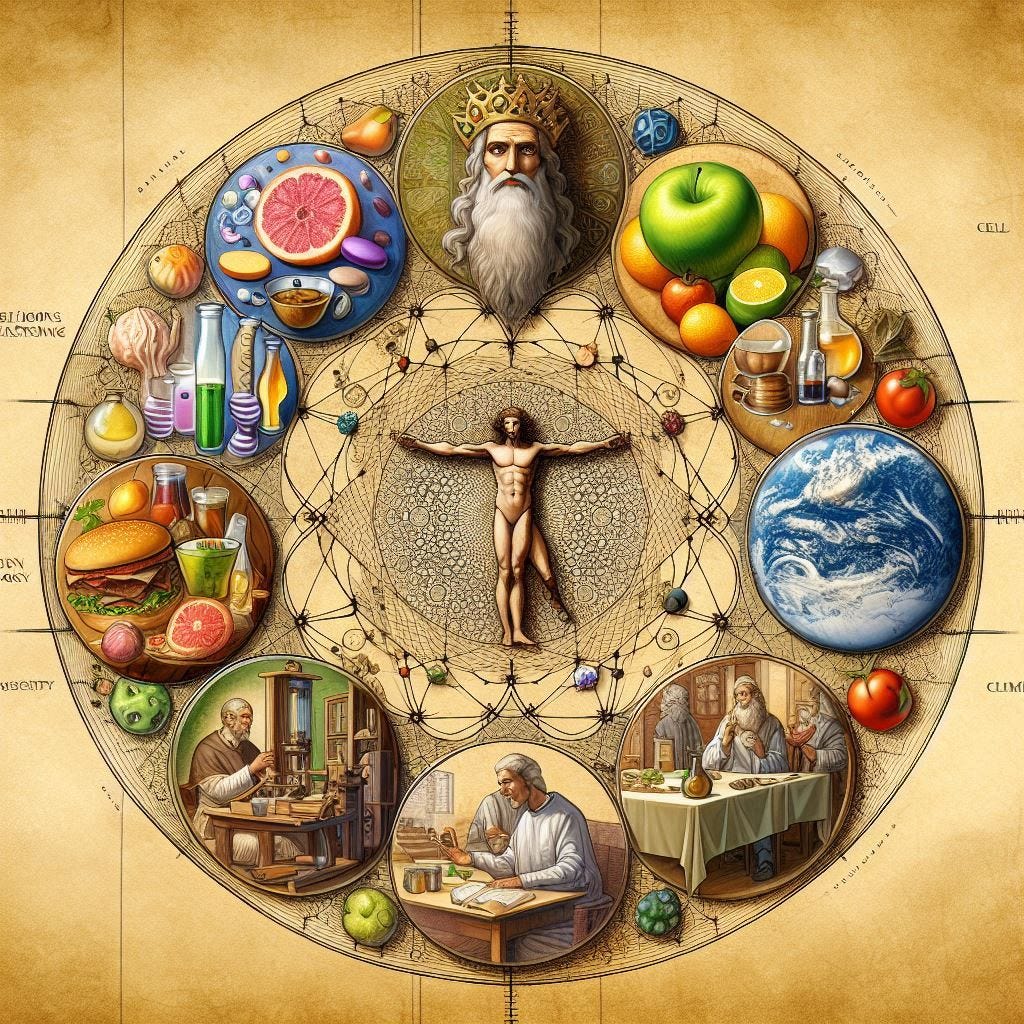A version of this article first appeared in the Hindustan Times on 02/03/2025.
An AI-generated conversation based on this article is available here. A little more error prone than usual. Millets don’t necessarily use less water, when adjusted for yield, but they tend to be more climate resilient.
As the crescent moon rises this week, Muslims begin their period of restraint, when they can eat only until, “until the white thread of light becomes distinguishable from the dark thread of night at dawn”. Then they fast, abstaining from food and water, until the moon rises again. In a few days from now, many Christians begin fasting for Lent. Some give up meat (or indeed, chocolate), others solid food, and still others fasting from sunrise to sundown. Hindus fast more intermittently: on certain days of the week (Tuesdays are quite popular), or during some phases of the moon (Ekadashi for instance). Fasts vary here also: some abstain from meat and liquor, others stick to liquid food and fruits, while some consume no food at all. Navratri sees many fast until the evening offerings are made to the Goddess. On Janmashtami, my grandmother ate nothing even as she prepared dozens of sweets, only breaking fast after the evening puja. Jains fast more often, more strictly and for longer. All religions see fasting as progress on one’s spiritual journey.
Fasting – in its splendid diversity – has been an essential part of life for humans over the millennia.
Is there more to it?
There is a whole slew of literature: scientific, statistical and popular, that show that humanity may be over nourished today. Data from the Food and Agriculture Organization of the United Nations (FAO), processed by the website, Our World in Data, shows that calories available per person has increased from 2181 calories per day in 1961 to 2959 in 2021. The averages conceal an enormous variation, but by most measures, the world is providing ample food for its masses. In India, the same dataset shows, daily calories available per person rose from 1570 in 1948 to 2569 in 2021. That’s a stupendous feat, considering our relatively low crop yields and ballooning population. Only, now we may have too much of a good thing. The latest National Family Health Survey tells us that fewer Indians are going hungry. Indeed, for the first time in records, a greater share of Indian women is overweight than underweight.
As the Tamil Proverb says, “Azhavukku meerinaal amirthamum nanju” (if you exceed limits, even ambrosia is harmful). Our body’s biochemistry evolved in an era of calorie constraints. Our biological ancestors, near and far, competed in a scrappy, mean street fight to eat and reproduce, and over time, our biochemistry, like chemical scars from a fight, ensures our body will do whatever it can to use energy efficiently and store any excess energy as fat.
The effect of these extra calories is playing out in the interstices of our cells. Nestled within the cytoplasm of our cells is a protein called MTOR (mechanistic target for rapamycin – it really needs a new name), a sort of master switch of cell growth. Nutrition (primarily) turns it on. Then the cell grows and stores energy. Surely, this is a good thing. Yes, up to a point. When one eats too much, MTOR is continuously turned on, leading to uncontrolled cell growth (with higher chances of cancer), storing too much fat, liver damage, insulin resistance and fatty deposits in the arteries. Continuous activation also pauses autophagy (Greek, auto = self; phagia = eating), referring to the process of repair and renewal in a body, where metaphorically and somewhat literally, the cell eats itself. This is an essential process, where damaged organelles and faulty proteins are broken down and the debris turned into parts for later rebuilding. When this renewal doesn’t happen, cellular damage accumulates, accelerating aging and neurodegeneration (think Alzheimer's or Parkinson's). Casey Means, Stanford-trained physician and author of bestseller ‘Good Energy’, writes that asking our body to process our “chronic overnutrition”, is like “being asked to do 700 to 3,000 % more work than you normally do daily – you’d collapse!”. And it does appear that our cells are collapsing.
Which brings us back to fasting. Studies in several species – yeast, mice, men – has shown fasting, or some form of calorie restriction, not only elongates lifespan but as per physician and best-selling author of “Outlive”, Peter Attica, also extends healthspan, the age up to which one can remain healthy and active. Which explains why a recent article in Medscape, a site that provides medical information to healthcare professionals and consumers, titled, “Is Intermittent Fasting Safe and Beneficial?”, concludes Yes, it is.
But why am I talking about fasting?
Because fasting, apart from meaningfully improving personal health, may improve planetary health as well. The same Medscape article quotes biogerontologist, Valter Longo, as saying by “eating only during 11 hours a day, the person will consume 7000-15,000 fewer calories per month”. This, as fasting practices go, is not terribly arduous: Eating one’s first meal at 9 am, and wrapping up dinner by 8 pm. Does this have climate consequences? To answer this, let’s conduct a thought experiment: First, let’s assume only diabetics and pre-diabetics (those who are likely to develop full blown diabetes in the short run) adopt this restriction. That number, in India, as per the World Health Organization, is about 102 million. Further, let’s assume any saved calories come by cutting the quantum of rice in our meals. This fast would save between 6 to 13 million tonnes of CO2-equivalent emissions a year, or about as much as taking all of Delhi’s vehicles off the road for 4 to 8 months a year. The water saved is far more consequential: at between 23 to 51 billion litres per day, it can meet the drinking water needs of Delhi, Mumbai, Chennai, Bengaluru, Kolkata and Hyderabad a couple of times over! The numbers are slightly less stellar, but still impressive, when sugar rather than rice is cut to save calories.
Fasting (by even just the profoundly metabolically unhealthy people) can be tremendously climate impactful. Not everyone can or should cut calories or fast. But too many of us are eating more than we ought.
Interestingly, a long-term calorie restriction study on monkeys by two different groups (University of Wisconsin and National Institutes of Health) found that in one group, where the monkey’s diets were rich in sugars and processed food, calorie restriction showed a significant increase in monkey lifespan. But in another group, where monkeys were fed a more natural diet, calorie restriction did not result in significant increase in lifespan. Clearly, apart from calorie restriction, quality of food also matters when it comes to longevity. Less naked carbohydrates and more natural foods are good for us – no surprise! Now, if we only expand the definition of food security to encompass health, what we eat and what we grow will be different. Could that guide us to grow more climate-resilient millets, which, with their lower yields, may result in a lower output than if the same area was to grow rice (assuming watering constraints did not exist), but that lower output would not matter because we were consuming less? The Prime Minister has flagged obesity as a cause for concern in his latest Mann ki Bhat – should that translate to educating the masses and changing what the government procures and distributes?
Because what we eat has and continues to reshape the planet. Forests cleared, rivers polluted, air smoked up, biodiversity shattered. Food accounts for 70% of our global water use and is responsible for about a quarter of emissions. It’s the planet’s predominant customer, and when a major customer changes track, the supplier follows suit.
How can we sell this idea? My sense is that if we frame fasting as a climate impactful action, we will face enormous pushback. But, when fasting is seen as securing karmic brownie points, it may, I believe, get more takers. Perhaps our ancestors realised this. Indeed, Lent occurs at a time when food stocks would have been running low, as the harvest period of the traditional crops is Israel at that time came a month later. So, if people ate less, the kingdom was secure. What better time to commune with God and fast? Ramadan, drawn from the Arabic root, for ‘Scorching heat’, may have been a time when lying low in the day would have made sense. My mother-in-law always says, “Langanam param aushadham” – a Sanskrit phrase meaning, hunger is the best medicine.
Another way to sell this idea is through biochemistry. MTOR is a highly conserved protein – it or its homologues exist and play a similar role in organisms as evolutionarily separated as yeast and us. This is a testament to its centrality to Life, and suggests it may not mutate too easily. In a figurative arm-wrestling match between MTOR-becoming-less-responsive-to-overnutrition or overnutrition-disappearing, my bet would be on the latter. Already, climate is threatening harvests, and reducing the nutritional value of several crops – rice that grows within an environment with higher CO2 levels contains less protein, zinc, iron and B-vitamins. Walk down this path and food insecurity for the mainstream, not just the marginalized, becomes plausible.
Consuming less food is up to us – difficult as that thought is to stomach. I’m currently undergoing a calorie restriction in my diet: some bloodwork results were a bit off, and the black-and-white truth of my test results meant I had to eat less. I even asked my nutrition consultant if I could have a special genetic test – surely, there must be some faulty gene at play. She said no – I don’t think you are suitable for a genetic test, because your body and biochemistry are behaving exactly as they are supposed to. “You’ve just been having too much food for too long.” That must change. Amen.
Further Reading
Outlive - Dr Peter Attia with Bill Gifford
Good Energy - Dr Casey Means with Calley Means
The Longevity Diet - Valter Longo




The Parsis have no custom of fasting nor any other restraint on their behaviour imposed by their customs. In times past this caused such an enormous crush of the practitioners of other faiths to convert to Zoroastrianism as to result in such conversion being banned, so that those faiths could continue to exist. Had the ban not been imposed, Akhand Bharat would have stretched uninterrupted from Seattle to Soul. And climate change would have occurred centuries ago. 😂😂😂
Lesser the population, more will be the availability of food. And therby crave for food automatically gets reduced.....Controlled intake of food helps maintenance of body...